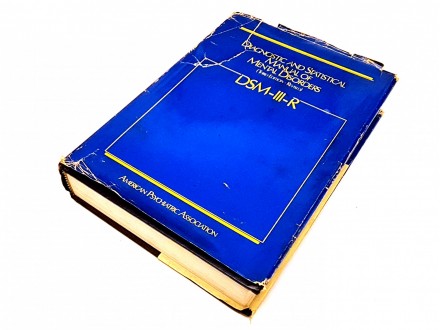Diagnostic and Statistical Manual of Mental Disorders
| Cena: |
| Želi ovaj predmet: | 1 |
| Stanje: | Polovan bez oštećenja |
| Garancija: | Ne |
| Isporuka: | BEX Pošta Post Express Lično preuzimanje |
| Plaćanje: | Tekući račun (pre slanja) PostNet (pre slanja) Ostalo (pre slanja) Lično |
| Grad: |
Novi Beograd, Beograd-Novi Beograd |
ISBN: Ostalo
Godina izdanja: 1987.
Jezik: Engleski
Oblast: Psihijatrija
Autor: Strani
Diagnostic and Statistical Manual of Mental Disorders
Third Edition - Revised
DSM - III - R
Izdavač: The American Psychiatric Association
Vašington DC, SAD 1987. Tvrd povez, zaštitni omot, engleski jezik, XXVII + 567 strana.
V6
Na predlistu posveta doktoru Jovanu Raškoviću.
Napomena: oštećenja zaštitnog omota; ako se to izuzme, knjiga je odlično očuvana.
The Diagnostic and Statistical Manual of Mental Disorders, Third Edition (DSM-III) published by the American Psychiatric Association in 1980, and now translated in many languages, has raised a great interest in the whole world. It has probably had on psychiatric thinking as important an impact as the Treatise of Psychiatry of E. Kraepelin at the beginning of the century. The evolution of psychiatric nosology and the circumstances of the birth of DSM-III are described. In discussing the general principles and the technical aspects, the influence of several currents of thought are emphasized: recent remedicalization of psychiatry in the United States, suspicion about speculative theories, return to an a-theoretical clinical descriptive nosology, influence of quantitative differential psychology and of the models provided by computer diagnosis. The nature of the two basic principles: the necessity of attaining a proven high interjudge reliability in diagnosis, and the descriptive a-theoretical nature of the description of each category is analyzed. From those principles derive the most original features of the DSM-III: the use of stringent diagnostic criteria, of a possible quantitative nature and the adoption of a multi-axial system. Some of the most striking changes introduced are the logical consequences of the principles e.g. the deletion of the term `neurosis`. Others changes such as the introduction of new diagnostic categories or changes in the limits of classical ones (especially schizophrenia and manic-depressive psychosis) reflect a reaction against previous trends of American psychiatry and a strict adherence to a pragmatic and empirical thinking. In addition, the flexibility of its structure allows for the incorporation of new empirical results. In spite of many criticisms, either against the general orientation or against specific positions, some of which are presented in the course of this article, it is concluded that the success of the DSM-III results from a trend in psychiatric thinking not confined to the United States. Its controversial nature has stimulated the reappraisal of old concepts, and it can be considered as an important contribution towards a closer integration of psychiatry to medicine.
Predmet: 74041829







